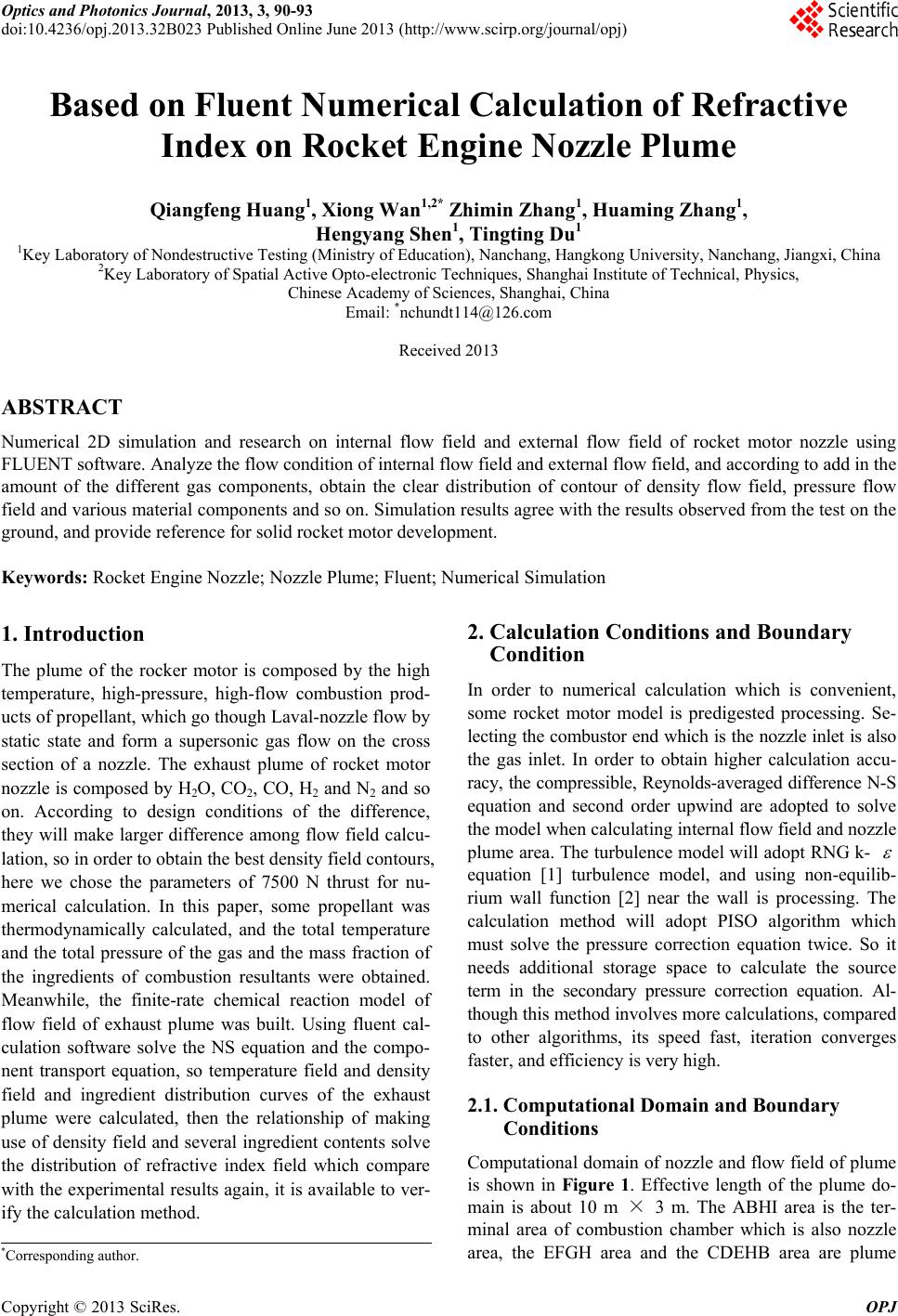
Optics and Photonics Journal, 2013, 3, 90-93
doi:10.4236/opj.2013.32B023 Published Online June 2013 (http://www.scirp.org/journal/opj)
Based on Fluent Numerical Calculation of Refractive
Index on Rocket Engine Nozzle Plume
Qiangfeng Huang1, Xiong Wan1,2* Zhi min Zhang1, Huaming Zhang1,
Hengyang Shen1, Tingting Du1
1Key Laboratory of Nondestructive Testing (Ministry of Education), Nanchang, Hangkong University, Nanchang, Jiangxi, China
2Key Laboratory of Spatial Active Opto-electronic Techniques, Shanghai Institute of Technical, Physics,
Chinese Academy of Sciences, Shanghai, China
Email: *nchundt114@126.com
Received 2013
ABSTRACT
Numerical 2D simulation and research on internal flow field and external flow field of rocket motor nozzle using
FLUENT software. Analyze the flow condition of internal flow field and external flow field, and according to add in the
amount of the different gas components, obtain the clear distribution of contour of density flow field, pressure flow
field and various material components and so on. Simulation results agree with the results observed from the test on the
ground, and provide reference for s ol id rocket m ot or development.
Keywords: Rocket Engine Nozzle; Nozzle Plume; Fluent; Numerical Simulation
1. Introduction
The plume of the rocker motor is composed by the high
temperature, high-pressure, high-flow combustion prod-
ucts of propellan t, wh ich g o thoug h Lava l-nozzle f low b y
static state and form a supersonic gas flow on the cross
section of a nozzle. The exhaust plume of rocket motor
nozzle is composed by H2O, CO2, CO, H2 and N2 and so
on. According to design conditions of the difference,
they will make larger difference among flow field calcu-
lation, so in order to obtain the best density field contours,
here we chose the parameters of 7500 N thrust for nu-
merical calculation. In this paper, some propellant was
thermodynamically calculated, and the total temperature
and the total pressure of the gas and the mass fraction of
the ingredients of combustion resultants were obtained.
Meanwhile, the finite-rate chemical reaction model of
flow field of exhaust plume was built. Using fluent cal-
culation software solve the NS equation and the compo-
nent transport equation, so temperature field and density
field and ingredient distribution curves of the exhaust
plume were calculated, then the relationship of making
use of density field and several ingredient contents solve
the distribution of refractive index field which compare
with the experimental results again, it is available to v er-
ify the calculation method.
2. Calculation Conditions and Boundary
Condition
In order to numerical calculation which is convenient,
some rocket motor model is predigested processing. Se-
lecting the co mbustor end which is the nozzle in let is also
the gas inlet. In order to obtain higher calculation accu-
racy, the compressible, Reynolds-averaged difference N-S
equation and second order upwind are adopted to solve
the model when calculating internal flow field and nozzle
plume area. The turbulence model will adopt RNG k-
equation [1] turbulence model, and using non-equilib-
rium wall function [2] near the wall is processing. The
calculation method will adopt PISO algorithm which
must solve the pressure correction equation twice. So it
needs additional storage space to calculate the source
term in the secondary pressure correction equation. Al-
though this me t h o d invo lves more ca lc ulati ons, compar ed
to other algorithms, its speed fast, iteration converges
faster, and efficiency is very high.
2.1. Computational Domain and Boundary
Conditions
Computational domain of nozzle and flow field of plume
is shown in Figure 1. Effective length of the plume do-
main is about 10 m × 3 m. The ABHI area is the ter-
minal area of combustion chamber which is also nozzle
area, the EFGH area and the CDEHB area are plume
*Corresponding author.
Copyright © 2013 SciRes. OPJ